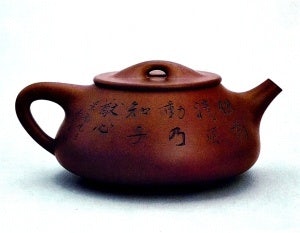Collectors Break World Record At Auction Of Rare And Historical Traditional Teapots In Beijing#

With the auction world keeping a close eye on the purchasing habits of Chinese collectors, noting that antiquities from select historical eras (previously) and works by blue-chip traditional and contemporary Chinese artists are "must-haves" for a growing number of wealthy Chinese, it's always interesting to watch the auctions that aren't widely reported outside of the Chinese-language media to get some insight into what else collectors in China are buying. In addition to jade and jewelry, collectors in China with a penchant for the country's traditional arts have increasingly turned to -- and currently dominate -- segments like imperial-era snuff bottles (which sold out at the recent Christie's Spring Auctions in Hong Kong) and rare teapots (one of which just sold for nearly $2 million).
This dominance isn't exactly a coincidence. For one thing, domestic Chinese auction houses have ample supplies of Chinese traditional arts -- including teapots -- and for another thing, non-Chinese collectors have little presence in the teapot auction world, unlike what we see in other segments like Chinese contemporary art or traditional ink paintings. Demand, and competition, for particular teapots is virtually limited only to Chinese collectors, then, buying from Chinese auction houses. Although there are of course occasional teapots up for grabs at Sotheby's or Christie's in Hong Kong, mostly from the older collections of Western collectors, the bulk of recent auctions have been in mainland China.
Of these, one of the most noteworthy is the recent China Guardian auction of purple clay, or zisha, teapots (紫砂壶). Made from a type of clay found near the city of Yixing in Jiangsu province, zisha teapots are coveted by collectors due to the craftsmanship of Yixing masters as well as the strength, relative rarity and beauty of the fired clay itself. At the recent Guardian auction, a single teapot created in 1948 by master Gu Jingzhou (顾景舟) with calligraphy by Wu Hufan (吴湖帆) set a new world record, selling for 12.32 million yuan (US$1.8 million), indicating that Chinese collectors are just as willing to go far beyond estimates for a particular item whether it's an oil on canvas or a teapot. Though prices are skyrocketing in the teapot world -- leading, perhaps inevitably, to scandals (Chinese) -- Chinese sources seem to think that prices will continue to rise steadily.
From the New Beijing Times (translation by Jing Daily team):
China Guardian recently held its 2010 Spring Auction in Beijing, which pulled in a total of 2.13 billion yuan (US$312 million), setting a new quarterly record for an auction in mainland China. In the ceramics and teapots segment, total turnover reached more than 340 million yuan (US$50 million).
Among the items [sold in that segment] was an early masterpiece made in 1948 by Gu Jingzhou with calligraphy by Wu Hufan. This lot caused fierce bidding to break out when it hit the stage, eventually selling for around five times above its estimates for a grand total of 12.32 million yuan (US$1.8 million), setting a new world record for a teapot auction.
The article goes on to quote professor Jiang Hua of the Chinese Academy of Arts, who says that the high price fetched by rare teapots "reflects the role that culture plays in the evaluation of prices for zisha teapots." Sun Wanyi of the Beijing Gu Tianyi International Auction House then points out that prices for teapots from popular dynasties like the early Qing -- which he feels are highly undervalued -- are only going to rise faster as more collectors get in the game.
Says Sun,
The price of teapots from the early Qianlong period (1735-1796 CE) or earlier will rise even faster in the next two to three years, with no possibility of a reversal. These teapots are extremely rare, with optimistic estimates placing the number of teapots in very good condition at around 300-500 and pessimistic estimates putting them at around 200. Therefore, in terms of price, these teapots should cost several million yuan, yet currently we see them priced only at several thousand.